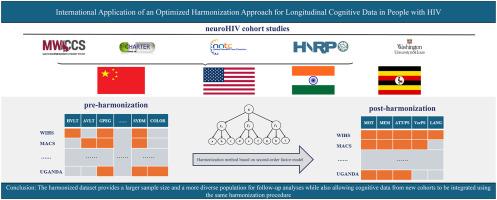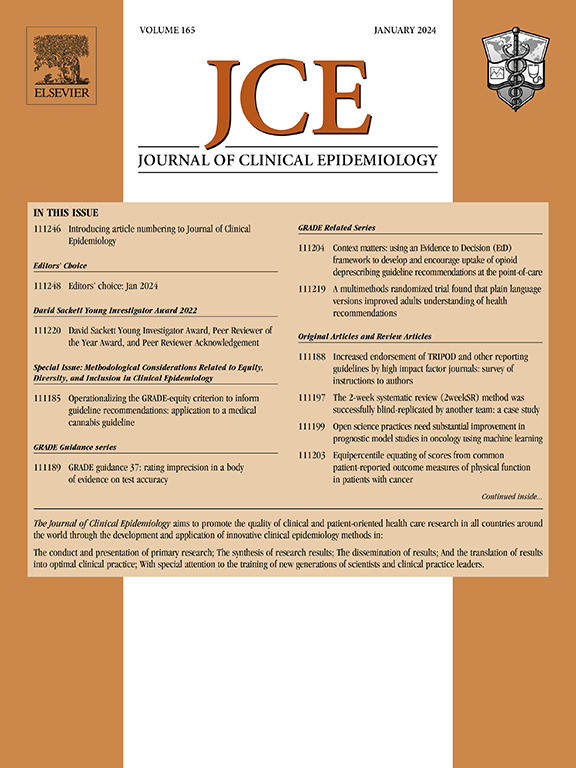International application of an optimized harmonization approach for longitudinal cognitive data in people with HIV
IF 5.2
2区 医学
Q1 HEALTH CARE SCIENCES & SERVICES
引用次数: 0
Abstract
Objectives
We previously developed a refined longitudinal data harmonization method to address the challenge of nonoverlapping cognitive tests across cohorts, successfully harmonizing data from 5 large-scale US HIV studies. Building on this harmonized data set, we now aim to apply this method to an additional US HIV study and cognitive data from HIV studies in China, India, and Uganda. This effort will result in a more comprehensive data set with a larger, internationally diverse sample that includes both people with HIV and people without HIV.
Study Design and Setting
The new cohorts to be harmonized included cognitive tests that did not fully overlap across studies, a challenge for traditional harmonization methods. We applied our refined approach, designed for scenarios without direct test linkage. In the Uganda cohort, where a key method assumption was violated, we implemented targeted adjustments.
Results
The harmonized cognitive domain scores were consistent across cohorts and strongly correlated with raw or log-transformed cognitive test data (eg, timed outcomes). These scores preserved key patterns of variation observed in the raw data for key demographics—such as age, education, and race—and maintained age-related longitudinal trajectories of cognitive performance derived from all participants’ visits.
Conclusion
The resulting harmonized data set includes 18,270 participants across multiple countries, significantly enhancing its diversity and utility. It lays the groundwork for developing normative data and conducting more robust analyses to address critical neuro-HIV research questions. This study also demonstrates the adaptability of the refined harmonization method in integrating new data and accommodating methodological challenges.
Plain Language Summary
People with HIV (PWH) often face a variety of cognitive challenges, but these issues can look different for each person. As different studies use different tests to measure cognitive abilities, it is difficult to combine the results from multiple studies and draw clear conclusions. In our previous work, we developed a refined method to harmonize data from 5 large US-based HIV neuro studies. Such method could handle the scenarios where nonoverlapping cognitive tests are used in certain domains across different studies. We now aim to include additional cohorts from the United States, China, India, and Uganda. Because these new cohorts also use nonoverlapping cognitive tests in certain domains, we applied our developed approach to harmonize the new data into our previously harmonized data. Our refined method created “harmonized scores” for cognitive abilities that closely matched the original test results. These scores captured differences related to age, education, and other factors while preserving how each person's cognitive abilities changed over time. By using this method to combine new data with existing data, we were able to create a more comprehensive and diverse data set. This will aid researchers to better understand the wide range of cognitive changes in PWH, leading to stronger, more inclusive studies on the impact of HIV on cognition.

艾滋病毒感染者纵向认知数据优化协调方法的国际应用。
目的:我们之前开发了一种改进的纵向数据协调方法,以解决跨队列非重叠认知测试的挑战,成功地协调了来自美国五项大规模艾滋病毒研究的数据。在这个统一数据集的基础上,我们现在的目标是将这种方法应用于另一项美国艾滋病毒研究和来自中国、印度和乌干达艾滋病毒研究的认知数据。这一努力将产生一个更全面的数据集,其中包括艾滋病毒感染者(PWH)和非艾滋病毒感染者(PWoH)的更大,国际多样化的样本。研究设计和设置:需要协调的新队列包括认知测试,这些测试在研究中没有完全重叠,这对传统的协调方法是一个挑战。我们应用了为没有直接测试链接的场景而设计的改进方法。在乌干达队列中,一个关键的方法假设被违反,我们实施了有针对性的调整。结果:统一的认知领域分数在队列中是一致的,并且与原始或对数转换的认知测试数据(例如,时间结果)密切相关。这些分数保留了在关键人口统计数据(如年龄、教育程度和种族)的原始数据中观察到的关键变化模式,并维持了所有参与者访问所得的与年龄相关的认知表现的纵向轨迹。结论:由此产生的统一数据集包括来自多个国家的18,270名参与者,显著增强了其多样性和实用性。它为开发规范数据和进行更有力的分析以解决关键的神经艾滋病毒研究问题奠定了基础。本研究还证明了精细化协调方法在整合新数据和适应方法挑战方面的适应性。
本文章由计算机程序翻译,如有差异,请以英文原文为准。
求助全文
约1分钟内获得全文
求助全文
来源期刊

Journal of Clinical Epidemiology
医学-公共卫生、环境卫生与职业卫生
CiteScore
12.00
自引率
6.90%
发文量
320
审稿时长
44 days
期刊介绍:
The Journal of Clinical Epidemiology strives to enhance the quality of clinical and patient-oriented healthcare research by advancing and applying innovative methods in conducting, presenting, synthesizing, disseminating, and translating research results into optimal clinical practice. Special emphasis is placed on training new generations of scientists and clinical practice leaders.
 求助内容:
求助内容: 应助结果提醒方式:
应助结果提醒方式:


